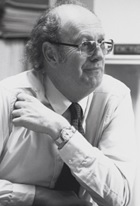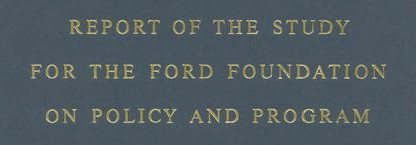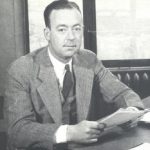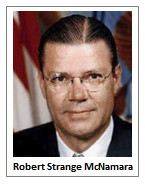________
Source: Technocratic Tyranny
Foundations: Social Engineers for Gaming the Public
By Vicky Davis | August 1, 2019
On July 8, 2016, Howard Raiffa died in his home in Tucson Arizona at the age of 92 years. While a professor at Harvard University, Raiffa and his colleagues created a new field of economics and they established an MBA program for it. The field was called Managerial Economics.
Raiffa came to Harvard Business School in 1957, "one of a small cadre of discipline-based scholars imported into this School," in Dean Clark's words, "through the generosity of the Ford Foundation, as part of a larger movement to broaden the intellectual base of business schools nationwide." The experiment worked. Raiffa had found a lifelong home at Harvard University…although Raiffa had had no experience in business, he was "vitally interested in how systematic thinking could help decision making."
Gaither became president of the Foundation in 1953 and served in that position through 1956. He became Chairman of the Board in 1956.
[Image right] H. Rowan Gaither
Raiffa came to Harvard Business School in 1957, "one of a small cadre of discipline-based scholars imported into this School," in Dean Clark's words, "through the generosity of the Ford Foundation, as part of a larger movement to broaden the intellectual base of business schools nationwide." The experiment worked. Raiffa had found a lifelong home at Harvard University…although Raiffa had had no experience in business, he was "vitally interested in how systematic thinking could help decision making."
"…he helped advance the fields of game theory, decision theory, and negotiation analysis… Raiffa's work, which was global in nature, spanned both public and private sector decision-making issues and included a deep interest in complex problems involving not only management but government policy, science policy, public health, and clinical medicine."
He inspired generations of academics at HBS, at Harvard (notably the Harvard Kennedy School), and the world at large, for example by bringing East and West together at the International Institute for Applied Systems Analysis (IIASA), the organization he helped found in Austria.
Ford Foundation Redefines Philanthropy
H. Rowan Gaither was hired by the Ford Foundation in 1947 to define a post-war mission for the Foundation. Gaither formed and directed a committee for the project. In 1949, they published the Report of the Study for the Ford Foundation on Policy and Program stating their mission and objectives. In the introduction, they state very clearly that they were moving beyond the traditional bounds of a philanthropic organization toward social engineering of the society. Unstated but implicit is that they were moving into the political arena because by definition, changing society is in every sense of the word, political.
Gaither became president of the Foundation in 1953 and served in that position through 1956. He became Chairman of the Board in 1956.
[Image right] H. Rowan Gaither
Between 1952 and 1954, there were two congressional committees investigating un-American Activities of tax-exempt foundations. Norman Dodd was the chief investigator for the Reese Commission to investigate foundations. H. Rowan Gaither was the Associate Director of the Ford Foundation when he testified before the committee on November 24, 1952.
RAND was established as a project under contract to the Douglas Aircraft Company in 1945. Major General Curtis LeMay was appointed to be the Deputy Chief of Air Staff for Research and Development. When Rand was spun off from Douglas, H. Rowan Gaither was retained as legal counsel to determine the best means of setting up Rand as an independent corporation.
From the History page of RAND:
Robert S. McNamara was appointed to the position of Secretary of Defense in 1961. McNamara got his undergraduate degree in economics from UC Berkeley. He then went to Harvard Business School to learn management techniques. From the Encyclopedia Britannica:
Please go to Technocratic Tyranny to continue reading.
RAND, Inc.
RAND was established as a project under contract to the Douglas Aircraft Company in 1945. Major General Curtis LeMay was appointed to be the Deputy Chief of Air Staff for Research and Development. When Rand was spun off from Douglas, H. Rowan Gaither was retained as legal counsel to determine the best means of setting up Rand as an independent corporation.
From the History page of RAND:
Excerpts from RAND's History
In May 1946, Project RAND released its first report, Preliminary Design of an Experimental World-Circling Spaceship, which discussed the potential design, performance, and use of manmade satellites. A year later, Project RAND moved from the Douglas plant to new offices in downtown Santa Monica. Project RAND also held a symposium in New York as a first step in enlisting social scientists for the organization.
… In February 1948, the Chief of Staff of the newly created United States Air Force wrote a letter to the president of the Douglas Aircraft Company that approved the evolution of Project RAND into a nonprofit corporation. Douglas. H. Rowan Gaither, Jr., a prominent San Francisco attorney who later served as president and then as chairman of the board of the Ford Foundation, was retained as legal counsel to determine the best means of setting up an independent RAND.
On May 14, 1948, RAND was incorporated as a nonprofit corporation under the laws of the State of California. The articles of incorporation set forth RAND's purpose in language that was both remarkably brief and breathtakingly broad:To further and promote scientific, educational, and charitable purposes, all for the public welfare and security of the United States of America.…In his 1996 doctoral dissertation (PDF) examining RAND's early years and the broadening of its research agenda, historian David Jardini of Carnegie Mellon University compiled an exhaustive list of contributions by RAND researchers, showing a reach that went far beyond assistance to military decisionmakers. These contributions include significant achievements in space systems, providing the foundation for America's space program, and important contributions to digital computing and artificial intelligence. (Researcher Paul Baran's work on packet switching, for example, provided the building blocks for today's Internet technology, and RAND staff designed and built one of the world's earliest computers.) RAND researchers also developed theories and tools for decision-making under uncertainty, and they made foundational contributions to game theory, linear and dynamic programming, mathematical modeling and simulation, network theory, and cost analysis.
Jardini singled out for special recognition a methodological approach called systems analysis, which provides information to military decisionmakers designed to "sharpen their judgment and provide the basis for more informed choices." As RAND's scope evolved and broadened, Jardini noted,systems analysis served as the methodological basis for social policy planning and analysis across such disparate areas as urban decay, poverty, health care, education, and the efficient operation of municipal services such as police protection and fire fighting.
Robert Strange McNamara
Robert S. McNamara was appointed to the position of Secretary of Defense in 1961. McNamara got his undergraduate degree in economics from UC Berkeley. He then went to Harvard Business School to learn management techniques. From the Encyclopedia Britannica:
During World War II, "he developed logistical systems for bomber raids and statistical systems for monitoring troops and supplies. After the war, McNamara was one of the "Whiz Kids" hired to revitalize the Ford Motor Company. His plans, including the institution of strict cost-accounting methods and the development of both compact and luxury models met with success, McNamara rose rapidly in the corporate ranks. In 1960 he became the first person outside the Ford family to assume the presidency of the company.After only a month as President of Ford Motor Company, JKF appointed McNamara to be the Secretary of Defense to lead a project of modernization of the Defense Department.
Please go to Technocratic Tyranny to continue reading.
________
Executive Vice President of the Ford Foundation Hilary Pennington, took $120 million from the Gates Foundation to turn your kid's education into a work-based-learning career pathway to the gig economy.
Executive Vice President of the Ford Foundation Hilary Pennington, took $120 million from the Gates Foundation to turn your kid's education into a work-based-learning career pathway to the gig economy.
Related:
Rockefeller Foundation's New Focus On Climate Change Signals The Next Phase Of The Great Reset
Stephen Bronfman: Justin Trudeau's Handler
More on Epstein:
Astonishing these weaponized philanthropies known as foundations are inside the Catholic church. If you do not understand yet what "inclusive capitalism" is then read about what these foundations are involved in with social credit bonds to bring children into conformity.
Ford Foundation behind funding the trans movement and LGBTQ+ groups. So why not boycott Ford like Americans boycotted Anheuser-Busch over their Bud Light advertising stupidity?
Maybe this will curtail the Ford Foundation's misanthropic grant-giving?





No comments:
Post a Comment
Note: Only a member of this blog may post a comment.